|
|
Samsung D500. Capabilities of the megapixel camera
D500 is the second GSM product camera by Samsung equipped with a megapixel.
First the same camera appeared in Samsung P730
when the company decided to apply a CMOS-matrix. As different to a CCD-matrix the
CMOS one is not so good and has much more noises in the majority of the modes.
An acceptable quality of the photos may be achieved only in the street in a sunny day.
Only Sharp and Sony Ericsson use CCD-matrixes in the European market.
If looking at their products you'll see the phones do not distinguish in a small size
(Sharp GX30,
Sony Ericsson S700).
The reason is the size of a CCD-module, it is rather big and integrating it without changing a typical
size of the phone is impossible. And taking into consideration their low price comparatively to
CCD-modules we may all understand the choice of the majority of the manufacturers. In general the
manufacturers do think the function is used seldom and optionally. That is why worse quality is
not considered critical especially if the size remains the same.
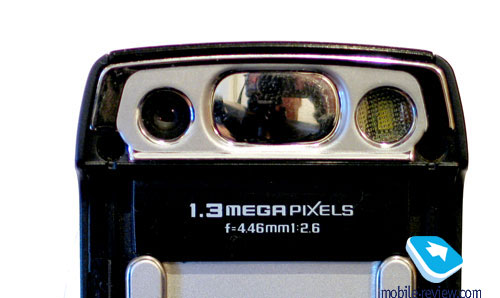
Samsung planned to improve a CMOS-matrix for 730 and achieve a comparable with
CCD-modules quality of the photo. We had an opportunity to make sure that hadn't happen and the quality
of the photos still leaves much to desire. The model is not the best in this parameter.
And thus it was interesting to look at D500 and compare it with the previous model.
Running ahead I'll say that another matrix, different electronics providing more qualitative photos in the
majority of the modes is used here. The quality of the camera is really higher than in those
many based on CMOS-technology and takes an intermediate position between them and CCD-cameras.
The models now represented in the market should be listed this way considering the increase of the
quality of the photos:
Motorola MPx220 (and all the phones by
Motorola, the worst quality), Samsung P730
(comparable with the phones by Motorola), Pantech GI100,
LG T5100,
Siemens S65,
Nokia 7610,
Nokia 6670 (average quality), Samsung D500,
Sony Ericsson S700,
Sharp GX30.
The camera is in the upper part of the slider and when the phone is closed it is hidden inside of the phone.
The construction protects from dust and scratches well and opening the device makes no trouble.
A mirror for a selfportrait and a flash (not impact) may be seen near the camera gap.
There are about 60 MB of memory for photos and video clips.
The camera works in 6 different resolutions:
- SXGA (1280x1024)
- Мега (1152x864)
- VGA (640x480)
- QVGA (320x240)
- QCIF (176x144)
- Sub- QCIF (128 x 96)
The compression quality for JPEG pictures is set separately, several types are available:
There are about 5 different sounds for a shutter and the sound may be turned off at all then
taking photos won't draw everybody's attention. A default file name, the sensitivity of the
matrix (Auto, ISO 100, ISO 200, ISO 400) may be set.
I'd recommend using an Auto mode because it works correctly mostly. The difference
between sensitivity modes is not felt in usual conditions. You won't see any
changes on a real photo. For example, look at these three photos of the fallen leaves
in the rain, the brightness is changed little. It's curious that is a rainy or a
foggy weather the automatics mechanism doesn't work correctly from the first seconds,
adjustment takes time (about 3-4 seconds, the contrast and colour changes are seen on the screen).
Similarly to SE S700 a point focus function that may be used in the majority of modes appeared,
The quality of the photos gets higher especially in the conditions when the scene is lighted not even.
The timer for selfshooting is set for 3, 5 or 10 seconds.
The matrix mode switches the camera to the lowest resolution (a final picture is 640 x 480 pixels) and
you get a picture that consists of 4 or 9 items (2x2 or 3x3). It's a curious mode that may be interesting
for experiments.
In a multishooting mode it's possible to select some series, in particular that may be 6 photos with
high speed (practically immediate pictures), with normal speed (the period between the photos is a second
or less). Also modes with 9 and 15 photos are available. I'll note that the function is interesting as a photofinish
at a competition, in real life if moving the camera the photos will be blurry in the majority of cases.
The resolution is 320x240 in this mode.
 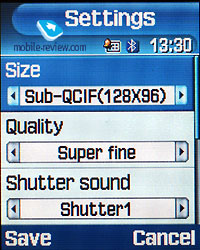
 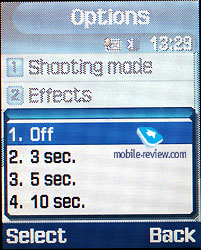
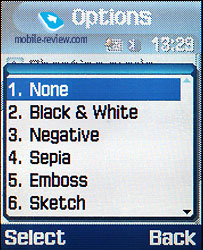 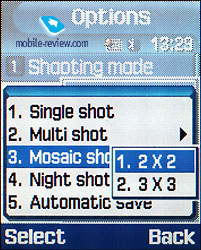
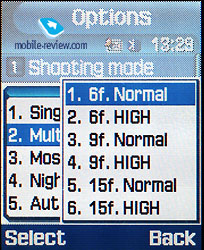 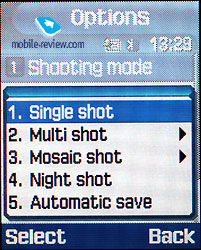
Switching into a shooting mode is done either by pressing a side button or via the menu. The screen of the phone serves as a
viewfinder, using a navi button you may change the contrast level and use zoom. When the resolution is maximum,
the zoom function is turned off automatically. The picture may be mirrored on the screen using
side buttons. When shooting one should remember the photo is taken with a delay of about a second, first the
focus appears on the screen and then the photo is taken. This process needs getting used to.

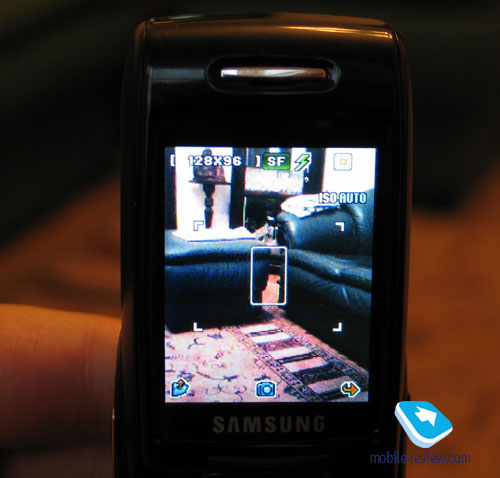
There is a number of effects in the phone that may be applied either during a shooting process or
while postediting. As for me, the second variant is more acceptable just like applying frames to the photos.
We'll just name the effects and you may get acquainted with them in a separate archive
(Black & White, Negative,
Sepia, Emboss, Sketch, Orange, Aqua, Red focus, Yellow focus, Blue focus). The last three effects
distinguish the main colors of the composition but the function is middling in the majority of cases.
According to the manufacturer the flash may get about 1 meter. Our tests proved the distance
between the flash and the object in the dark may be not more than a meter.
There are automatic and manual flash modes, in the last it is turned on by the request or works permanently.
In the room with a calndlelight the flash should be off not to spoil the pictures.

The quality of photos in the dark is comparable with other phones, for instance, Sharp GX30.
Unfortunately, the weather was not sunny and the camera was tested in the rainy days.
The quality of the pictures is rather high in such days and the picture is contrast.
I think, in sunny weather the photos will looks much worse. Comparing the photos with
Sony Ericsson S700 proved photos taken with D500 in a troublesome weather conditions look much more lifelike.
Here are also some photos taken with Samsung D500 in the street and in the room:
- Sample photo in the street ( SXGA, SuperFine, 140 KB)
- Sample photo in the street ( SXGA, SuperFine, 107 KB)
- Sample photo in the street ( SXGA, SuperFine, 94 KB)
- Sample photo in the room ( SXGA, SuperFine, 155 KB)
- Sample photo in the street ( SXGA, SuperFine, 231 KB)
- Sample photo in the street (Mega, SuperFine, 282 KB)
- Sample photo in the street (Mega, SuperFine, 128 KB)
- Sample photo in the street (Mega, SuperFine, 241 KB)
- Sample photo in the room (Mega, SuperFine, 221 KB)
- Sample photo in the room (Mega, SuperFine, 278 KB)
- Sample photo in the room (Mega, SuperFine, 266 KB)
The photos are kept in an album and here you may view the data on a certain photo (not above the photo as in previous models). The list is formed fast and indicates the phone name and a small icon.
Any photo may be assigned to a name in the phone book or set as a wallpaper just from the album menu.
There is a slide show mode, a plain editor that allows adding emotion icons, apply frames and effects to the photos.
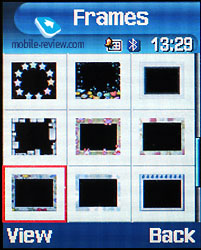 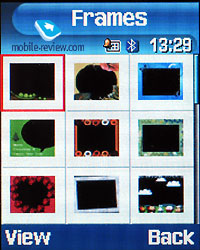
The quality of the picture is maximum for the phones of the current generation, the picture looks
vivid and the details are viewed well.
 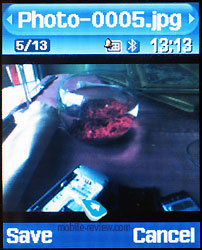
 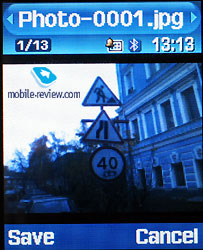
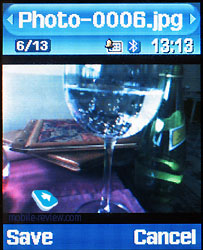
Any file including a photo may be sent to another phone via IrDA or bluetooth. The disadvantage is that
it's impossible to send all the files this way. At the same time Easy Studio version 2.0 (a renewed program)
is included into a standard kit, it allows transferring all the files to a PC at once, the program is more comfortable for
this operation.
Video
The phone records 3GP video and you may choose recording with sound or without it.
All the settings are comparable with similar for photos, the same 3 quality levels but the resolutions are
different. There are three of them:
- QQVGA 16 0x 1 20
- QCIF 176x144
- Sub-QCIF 128x96
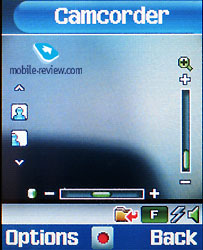
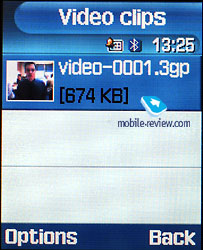
There is no any limit on the duration of the record and everything depends on the free memory.
Specially for MMS a recording mode that doesn't allow to exceed 100 KB is provided.
Short conclusion
The camera in D500 offers rather a great range of settings and the phone is small in size at the same time.
If comparing the quality of the camera with all the models in the market then it is
a bit inferior to CCD-matrixes in Sharp GX30, almost
comparable with Sony Ericsson S700
(in bad conditions it is comparable and even a bit better).
Comparison of the models with the same body size proves there is no alternative to D500 yet.
The delay of the release of a similar model by Sony Ericsson played a cruel joke with the manufacturer,
D500 offers the same functionality. In general if you need a megapixel camera D500 is not the
worst choice and even it's one of the models with good quality of the pictures that is higher than average.
It's the best model of this size.
Review Samsung D500>>>
Links on the topic:
Eldar Murtazin (eldar@mobile-review.com)
Translated by Maria Mitina (maria.mitina@mobile-review.com)
Published — 3 November 2004
Have something to add?! Write us... eldar@mobile-review.com
|
News:
[ 31-07 16:21 ]Sir Jony Ive: Apple Isn't In It For The Money
[ 31-07 13:34 ]Video: Nokia Designer Interviews
[ 31-07 13:10 ]RIM To Layoff 3,000 More Employees
[ 30-07 20:59 ]Video: iPhone 5 Housing Shown Off
[ 30-07 19:12 ]Android Fortunes Decline In U.S.
[ 25-07 16:18 ]Why Apple Is Suing Samsung?
[ 25-07 15:53 ]A Few Choice Quotes About Apple ... By Samsung
[ 23-07 20:25 ]Russian iOS Hacker Calls It A Day
[ 23-07 17:40 ]Video: It's Still Not Out, But Galaxy Note 10.1 Gets An Ad
[ 19-07 19:10 ]Another Loss For Nokia: $1 Billion Down In Q2
[ 19-07 17:22 ]British Judge Orders Apple To Run Ads Saying Samsung Did Not Copy Them
[ 19-07 16:57 ]iPhone 5 To Feature Nano-SIM Cards
[ 18-07 14:20 ]What The iPad Could Have Looked Like ...
[ 18-07 13:25 ]App Store Hack Is Still Going Strong Despite Apple's Best Efforts
[ 13-07 12:34 ]Infographic: The (Hypothetical) Sale Of RIM
[ 13-07 11:10 ]Video: iPhone Hacker Makes In-App Purchases Free
[ 12-07 19:50 ]iPhone 5 Images Leak Again
[ 12-07 17:51 ]Android Takes 50%+ Of U.S. And Europe
[ 11-07 16:02 ]Apple Involved In 60% Of Patent Suits
[ 11-07 13:14 ]Video: Kindle Fire Gets A Jelly Bean
Subscribe
|




















